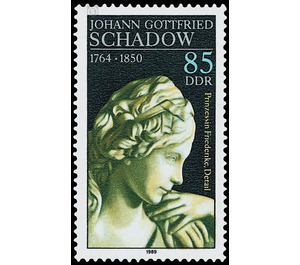225th birthday of Johann Gottfried Schadow - Germany / German Democratic Republic 1989 - 85 Pfennig
Theme: Art & Culture
| Country | Germany / German Democratic Republic |
| Issue Date | 1989 |
| Face Value | 85.00 |
| Color | black brown |
| Perforation | K 14 |
| Printing Type | Rotogravure 2 |
| Stamp Type | Postage stamp |
| Item Type | Stamp |
| Chronological Issue Number | 2993 |
| Chronological Chapter | GER-DDR |
| SID | 48300 |
| In 11 Wishlists | |
225th birthday of Gottfried Schadow On the occasion of the 225th birthday of Gottfried Schadow, the Ministry of Posts and Telecommunications of the German Democratic Republic issues two multicolored special postage stamps. Special cancellation from 16 May to 15 July 1989 225th birthday of JG Schadow Johann Gottfried Schadow (Berlin 20. 5. 1764 - 27. 1. 1850 Berlin) is next to Johann Heinrich Dannecker (1758-1841), who worked in Stuttgart With Schadow begins in Prussia as a "Berlin Sculpture School" designated, a century-long tradition of sculpture, in which follow such famous artists as Christian Daniel Rauch (1777-1857), Friedrich Tieck (1776 - 1851) and Ernst Rietschel (1804 - 1861). Schadow's oeuvre includes monuments - for example for General Hans Joachim von Zieten (1794, now Berlin, State Museums, Sculpture Collection, set up in the Soil Museum), sculptural jewelery (eg Berlin, Brandenburg Gate), tomb sculpture like the famous tomb of the late Count von the Mark (1788-1790, today Berlin, National Museums, National Gallery, situated in the main building of the National Gallery) and numerous busts of both members of the Prussian court as well as of artists, musicians and citizens. The "Doppelstandbild der Prinzessinnen Luise und Friederike von Preußen", created between 1795 and 1797, became famous as one of the most beautiful classical sculptures; it represents in its kind an extraordinary contribution to the sculpture of those decades around 1800. The sisters Luise and Friederike were daughters of the Duke Karl of Mecklenburg-Strelitz. They came to Berlin in 1794, Luise as Crown Princess was with Friedrich Wilhelm III. from Prussia and Friederike married to Prince Louis. As queen, Luise was later loved and revered by the Prussian people. She died at the age of thirty-four years in 1810. Both princesses had been portrayed by Schadow in 1794, and the sculptor reports in his memoirs that their beauty had persuaded the minister Friedrich Anton Freiherr von Heinitz (1725-1802) "to model the group of them to let a copy on a smaller scale be made according to the model to deliver several copies in porcelain bisque. " Thus, in 1795/96, the plaster model was created, which has been publicly exhibited since 1987 in the Friedrichwerder Church, a branch of the Nationalgalerie. In the ancestral building of the Notionalgalerie on Berlin's Museum Island, on the other hand, there is the marble version, which was completed in Schadow's workshop in 1797 and then stood for over a hundred years in Berlin's Royal Palace. This life-size marble version was commissioned when Schadow's model was well received. Schadow shows Luise not only as the older, more mature of the sisters, but also as the more energetic. He writes about her figure: "The headdress of the Crown Princess and the bandage under the chin was supposed to cover a swelling that had formed on the neck, but then disappeared again." It was imitated by the ladies of that time as a fashion. " Full of brotherly trust, Luise puts her left arm around the neck of Friederike; it grabs the hand with tender feeling. The sisters' intimate, emotional handling of one another conveys traits of that time, which was also called the "age of sensibility". The Postwertzeichen show, each as a section, the portraits of the princesses. The physiognomic differentiation between Luise standing upright, prudent and energetic, and Friederike looking somewhat dreamily and childlike, at the same time reveal differences in the psyche as well as in age and rank in the Prussian court. While the figures and garments of the marble copy were executed by Schadow's assistants, as was the custom at the time, he, the Prussian court sculptor, worked the faces himself. This shows how important it was for him to carry out the finest modeling himself. This sculpture is one of Schadow's most popular works. It unites in a unique way the genres of the monument and the image and gives an insight into the thinking and feeling of the time.


